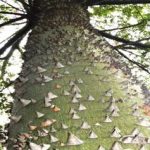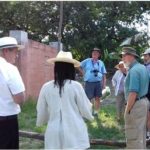TREE LIFE
May 2019
Tree Society Subs 2019-20 Subscriptions for the new financial year became due on 1st April 2019.
A number of members have paid in advance and need not make another payment. Their names are appended to the subs reminder email sent out by our treasurer.
Annual subs are $10 per family which can be deposited or transferred to our CABS account.
CABS Account Name: W.R.Clarke – Tree Society
Account Number : 1002549477
If you would prefer to pay by Ecocash you can transfer $10.50 to Bill Clarke’s Ecocash account and he will make the transfer to CABS. The extra 50 cents is to cover the transfer costs.
Ecocash – Registered recipient – W.R.Clarke – Phone number 0772252720.
Alternatively you can pay your $10 in cash to one of our committee members.
Whichever means you use to pay your subs, please notify Bill by email once you have paid. Proof of payment is not needed.
Tree Society outings for May 2019
Saturday May 4th: National Botanic Garden Walk. Meet in the Car Park at 0830 hours. This month we will look at trees in the Save-Limpopo Valley section. Non members and friends are very welcome to join us for these lovely, informative strolls in this beautiful woodland. So bring a friend.
Sunday May 19th: Annual General Meeting to be held at Mukuvisi Woodland Education Centre 9.30 am.
Any proposals/resolutions and nominations for office bearers (and any volunteers to be on the Committee) should be forwarded by email to the Secretary Teig Howson at teig.howson@gmail.com by Sunday 5th May if possible, although proposals and nominations will be accepted from the floor.
AGENDA
- Notice convening the meeting.
- Apologies.
- Minutes of the 68thA.G.M.
- Matters Arising.
- Chairman’s Report.
- Treasurer’s Report.
- Election of Committee Members.
- Any Other Business.
Order of events:
AGM at 9:30 am
Tea & Eats after AGM
Tree walk after Tea
You are requested to bring a plate of eats for tea. Members and non-members welcome but only members will be allowed to vote. Please note the different order of events – ie AGM first and then tea and then walk. If you feel like staying for either a picnic lunch or a light lunch at the Woodlands Restaurant, please feel free to do so.
Saturday May 25th: Ballantyne Park Conservancy. Meet at the Park at 1430 hours.
This is a delightful venue which has been lovingly restored/revamped to nearly its former glory by residents (it only needs a good rainy season and water in the dam to make it complete). Our own Meg Coates Palgrave has been on the “restoration/revamp” committee. Come and enjoy the park in general, the trees, the improvements, the play ground/fitness centre and good company. Bring a friend and also a thermos of tea for a cuppa after the walk.
National Botanic Garden Walk 6th April 2019 – Figs
We had a good turn out and split ourselves into two groups. In my group we had Russ, Asunción and Meghan being the new faces, Katharina (who came for the March walk has since become a member), while Ryan, Richard, Peter & Barbara, Teig and I made up the rest of the party. In the other group were Jan, Mark, Meg, Jim & Ann – this group went to try and identify an unknown fig tree near the Herbarium.
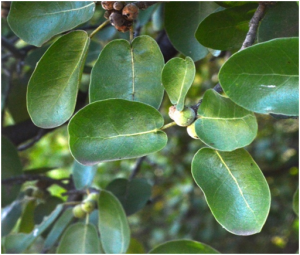
Ficus glumosa (Photo: Ryan Truscott)
We started with a fig tree whose identity eluded us for a long time. If we had seen this fig in the wild on rocks and it had the normal more rounded hairy leaves we wouldn’t have had a problem, but here it has small leaves and no sign of rock around, so it was out of context. This tree was finally identified after the last outing when Meg took a sample home with her – it’s the Hairy Rock Fig, Ficus glumosa.
We then found a Ficus sur which was competing for light with the other trees, it went straight up with hardly any side branches and all the figs were clustered just above ground level.
Before we came across the next fig tree we had a look at a Schinziophyton rautanenii – Manketti tree. We also looked at the Pawnbroker tree, Excoecaria bussei with its three lobed capsule fruits. After having investigated a Ficus burkei. Common Wild Fig, we came across another fig tree also labelled Ficus burkei but it was something else – it was another Ficus glumosa! Since we commenced labelling the trees, we have come across a number of mislabelled trees and here was another one. A tree with orange flowers drew our attention and we just had to have a look at it – it was a Colvillea racemosa which had just started flowering – it’s going to look very spectacular really soon.
We next looked at four exotic fig trees that we often see in Harare Gardens, two of them are fairly common – Ficus benjamina and Ficus elastica, the other two being Ficus lyrata and Ficus religiosa. A quick look at the Ficus sansibarica and then to the fig tree Mark had successfully identified near the Herbarium – it was Ficus benghalensis with its red, sessile fruits. After comparing Ficus ingens growing in the open and one growing in what would be its natural habitat, it was time to go home.
Botanising when the weather is great is always very satisfying!
-Tony Alegria
PLANTED TREES OF HARARE Harpephyllum caffrum
Harpephyllum caffrum, the Wild Plum, is endemic to Southern Africa, mostly occurring in coastal forests along the East coast but is also to be found in the Transvaal. In southern Africa it appears to be a single species in the genus Harpephyllum within Anacardiaceae (Mango family) which is the fourth largest tree family in southern Africa, boasting approximately 80 tree species. This is an attractive evergreen tree that is useful as an ornamental garden tree and in Harare it has also been planted as a street tree. With its thick crown and somewhat drooping leaves, the Wild Plum is a good shade tree in any garden.
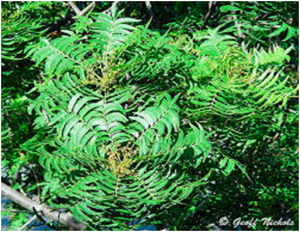
Harpephyllum caffrum leaves (source birdinfo.co.sa)
This is a large, evergreen tree that grows up to 15m tall and is usually found in riverine forests. The main stem is clean and straight, but the forest form often has supporting buttress roots. The dark grey-brown bark is smooth when young, becoming rough as it grows older. Branches are curved (bowed) upwards with leaves crowded towards the ends, forming a thick crown at the top of the tree.
The shiny dark green and glossy leaves are pinnate with sickle-shaped leaflets and are sometimes interspersed with the odd red leaf. Throughout summer, the whitish green flowers are borne near the ends of the branches with male and female flowers on separate trees (dioecious). The tasty plum-like fruits first appear green and then turn red when they ripen in autumn. They contain a single seed.
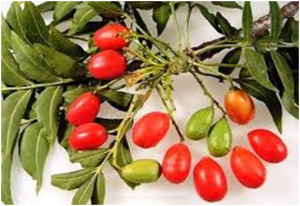
Harpephyllum caffrum fruit (source: witbos.co.za)
The fruits of Harpephyllum caffrum are widely utilised by birds, animals, insects and humans. Many animals, including bush-babies, monkeys, baboons and bushbuck, as well as birds such as Cape parrots, mousebirds, barbets, bulbuls, turacos, African green pigeons and other fruit-eating birds feed on the fruits of this tree. The fruit are commonly used for making jams and jellies but with their sour taste, they are also good to make rosé wine. The bark is a popular traditional medicine. It is used to treat pimples, acne and eczema and is usually applied in the form of facial saunas and skin washes. Powdered burnt bark is used to treat sprains and bone fractures. Bark is also used for dyeing, which gives a mauve or pink colour. The wood of Harpephyllum caffrum is pale reddish and fairly heavy, it polishes well but is not very durable. It has been used as a general purpose timber, for furniture and beams. It is also used for carving curios.
Larvae of the common Hairtail butterfly (Anthene definite) and the Eggar moth (Lasiocampa kollikerii) also feed on leaves of this tree which also often provides a home on its trunk and branches for orchids.
Source: plantzafrica.com
-Tony Alegria
OUTING TO HENRI HALLAM DAM 21 APRIL 2019
It was Easter Sunday and not all of us had to go in search of the hidden chocolate Easter eggs, as is part of European folklore on this day. Henri Hallam Dam, behind Manyame airbase, is a wild expanse of woodlands with its own characteristic vegetation. The woodlands are owned by City of Harare and entrance fee is $2.
A small group of tree-enthusiasts, including our two fundi, Mark and Meg, had gathered at the spot that had been marked out by Tony. We parked at a kind of sandy flood land between rocks and trees, some 3 km before the dam wall. Immediately our chairman took the lead and was already explaining some leaf characteristics to a new member. As it happened, consciously or not, the first tree was the chocolate berry (not the chocolate Easter egg) Vitex payos. The tree is easily recognized by its vertically fissured corky bark and digitate leaves. It had plenty of fruit, but not yet chocolate coloured ripe. Tony remarked that its opposite leaves are an unusual feature for trees with digitate leaves.
We looked at Ochna pulchra , Peeling-bark Ochna, and felt the raised mid-vein on the upper side of the leaf. We saw some more of these trees in this area. Also Ochna puberula, Granite Ochna, with the smaller leaves was present here. Psydrax livida, which was Canthium huillense before its name change, was omnipresent, many suckers and small shrubs, but also some mature small trees.
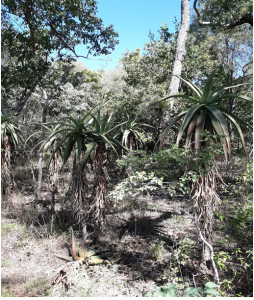
Aloe excelsa Photo by Jan van Bel
One of the first things that had caught people’s eyes was the majestic Aloe excelsa, Zimbabwe aloe, which were growing over a large area. They were about 3 m high with old leaves covering three quarters of their length, being one of the diagnostic features.
Grewia decemovulata, Miombo-dwarf donkey berry, which is a smaller shrub than the flavescens species and does not have the quadrangle stems. Coptosperma neurophyllum kopje butterspoon, and Aeschynomene, probably nodulosa sp. were also seen, as expected in this miombo type of woodland. A nice mature Pavetta schumanniana, Poison bride’s bush, with the typical dark bacterial nodules. A few Monotes glaber, Pale-fruited monotes, were seen. One was of considerable height, some were much younger. Indigofera rhynchocarpa, beak-fruited indigo tree, was also present here but we only saw one plant, their hockey-stick fruits ripe. The Combretum zeyheri, Large-fruited combretum, its 4-winged fruits large and still fresh light green. Diplorhynchus condylocarpon, Wild rubber, light green drooping leaves with milky latex, was an occasion for Meg to tell the story of some friends who got stuck with their car in the wild and were able to seal a leaking sump with the tree’s latex.
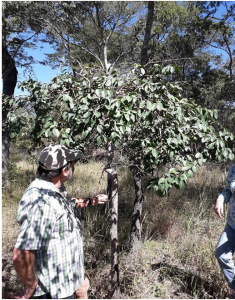
Strychnos cocculoides. Photo by Jan van Bel
Strychnos cocculoides, Corky-bark monkey orange, was not that corky and had a well-groomed outline.
We now had done half an hour of botanizing and had covered a distance of 5m. Certainly there were more different species we were going to see. The first Pterocarpus angolensis, Mukwa, and the first Burkea africana, for today. Two trees that when you see them, you feel some confidence that Nature is still in charge here. Other trees we had to find here and did, were Lannea discolor, Live-long ; Combretum molle, Velvet-leaved combretum ; Hexalobus monopetalus, Shakama plum ; Ximenia caffra, Large sourplum and Vangueria infausta, Wild medlar. Mundulea sericea, Cork bush was well represented here. It is an elegant small tree with compound leaves and hairy pods which were drying now. Rothmannia fischeri, Woodland Rothmannia, this one was a bigger tree than the other species we are used to seeing in Harare Botanical Gardens. It had much bigger fruits. Meg mentioned the occurrence of whorls of three leaves, besides the normal opposite leaves. Mystroxylon aethiopicum, Kooboo berry; Pseudolachnostylis maprouneifolia, Duikerberry; Albizia antunesiana, Purple-leaved albizia; Parinari curatellifolia, Mobola plum; Steganotaenia araliacea, Carrot tree, were all here as was expected. Vernonia glaberrima, often just a dry shrub, was observed. More Combretums were seen. On closer inspection and comparison, Meg decided that one was Combretum collinum, Variable combretum, subsp. suluense. It’s pods a bit smaller than the zeyheri species and its leaves lighter underneath. A Croton gratissimus, Lavender croton, had nice fragrant leaves and was added to the list.
A few really big trees were growing here. Pterocarpus rotundifolius, Mukwa, and what was seemingly an interesting and happy sighting for our guru’s: Boscia salicifolia, Willow-leaved boscia. Most trees in this area are quiet small and some would call them shrubs. One of these usual shrubby types and doing very well here, besides the Psydrax, was Tricalysia niamniamensis, Scaly-bark jackal coffee.
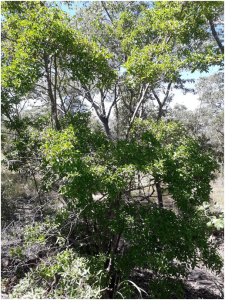
Tricalysia niamniamensis Photo by Jan van Bel
Some smaller plants observed here were Aeollanthus rehmannii and Crotalaria pallidicaulis and a Tephrosia species, but probably many more were recorded by our specialist Mark. Some better known shrubs here were Allophylus africanus (one as though sprouting from the middle of a rock) and Flueggea virosa, Snowberry tree, and a surprise sighting of several Ehretia amoena, Stamperwood, which although quite common, some of us had never encountered even after five years of treewalks. Some nice specimens were growing on an anthill. Here also was a Cassia abbreviata, Sjambok pod, getting very dry with frayed pods.
It was now time for picnic. Most people left for home to enjoy Easter lunch. Everyone agreed that it really was worth it and a follow up should be planned soon, maybe closer to the dam.
-Jan Van Bel.
Tree Society of Zimbabwe Website
I feel sure many of you will have seen mention of the new Website of the Tree Society. The old site had been set up and maintained for some years by Odette Linde, but sadly had fallen into a state of disrepair and was badly needing to be updated and upgraded.
During 2019 the Committee made positive moves towards getting this project moving again. We were fortunate enough to “discover” Tim Masson who understood our needs and proceeded to set up the Website for us. It is a fairly “user friendly” site, like all these things, once you know how. Tim is a very smart IT man and, sadly, expected us to be smart and as literate as he, as well. He gave us a couple of hours worth of tuition, at the end of which we had a severe and very confused knowledge “overload” and really could not make head nor tail of our carefully recorded notes.
We were again very fortunate that Mark Hyde kindly offered to host the site and so reduced the cost of running the site considerably. We also managed to persuade our very efficient and watchful Treasurer that this was going to be money well spent by the Tree Society for historical and botanic records reasons. This is one of the main reasons why I am appealing to members to look at the site and to understand and hopefully agree to the need to have these records for posterity.
It has been a mammoth learning curve for us “operators/uploaders” – Tony, Mark, Mary and Jim and we REALLY hope that you, the members of this Tree Society, will have a look at the site and appreciate the value of it as an Historical Record of the both the distribution of the woody species in Zimbabwe and the enormous amount of pleasure that members of the Tree Society have had recording these trees and of going out on, and appreciating our Tree Society outings over the years.
SO, the records and distribution of the trees and the Newsletters are NOT the only things of interest on the web site. There is the Home page with upcoming events and the other things that the Society is involved with like Tree Labeling at the Botanic Gardens, Mukuvisi Woodland, Ewanrigg, Haka Park and various other places that we have been asked to label trees – this has been an exciting outreach of the Society and one which we hope will make the general public more interested in the trees around them. We have a section on Discover Trees with bits about parasitic plants, fig pollination and thorns and prickles and things!! And trees of interest around the place, like White Jacarandas. There is also The Gallery with a huge collection of beautiful photographs of trees, their flowers and bark and pods etc. – lovely to browse through. For those interested, there is the “About Us” section which gives a short history of the Society and its doings and a section on “Links” with other organizations with similar interests – at the end of all this, and most importantly, there is “How to Contact Us” for anyone who wants to know something or to join the Society.
SO, again, please members, have a look at your Web Site, you have paid for it and it is yours to add to, (through one of the managers of the site), to criticize or to compliment on. Let us know your feelings and ideas on the concept of and how we have managed it thus far and how we can improve on it.
-Mary Lovemore
TONY ALEGRIA CHAIRMAN
Annual Subs are $10 per family per year (due in April) and can be deposited in the Society’s CABS account – Acc. No: 1002549477. Acc. name: W.R.Clarke – Tree Society.
PLEASE NOTE, IF YOU HAVE NOT PAID, THESE ARE DUE NOW.


